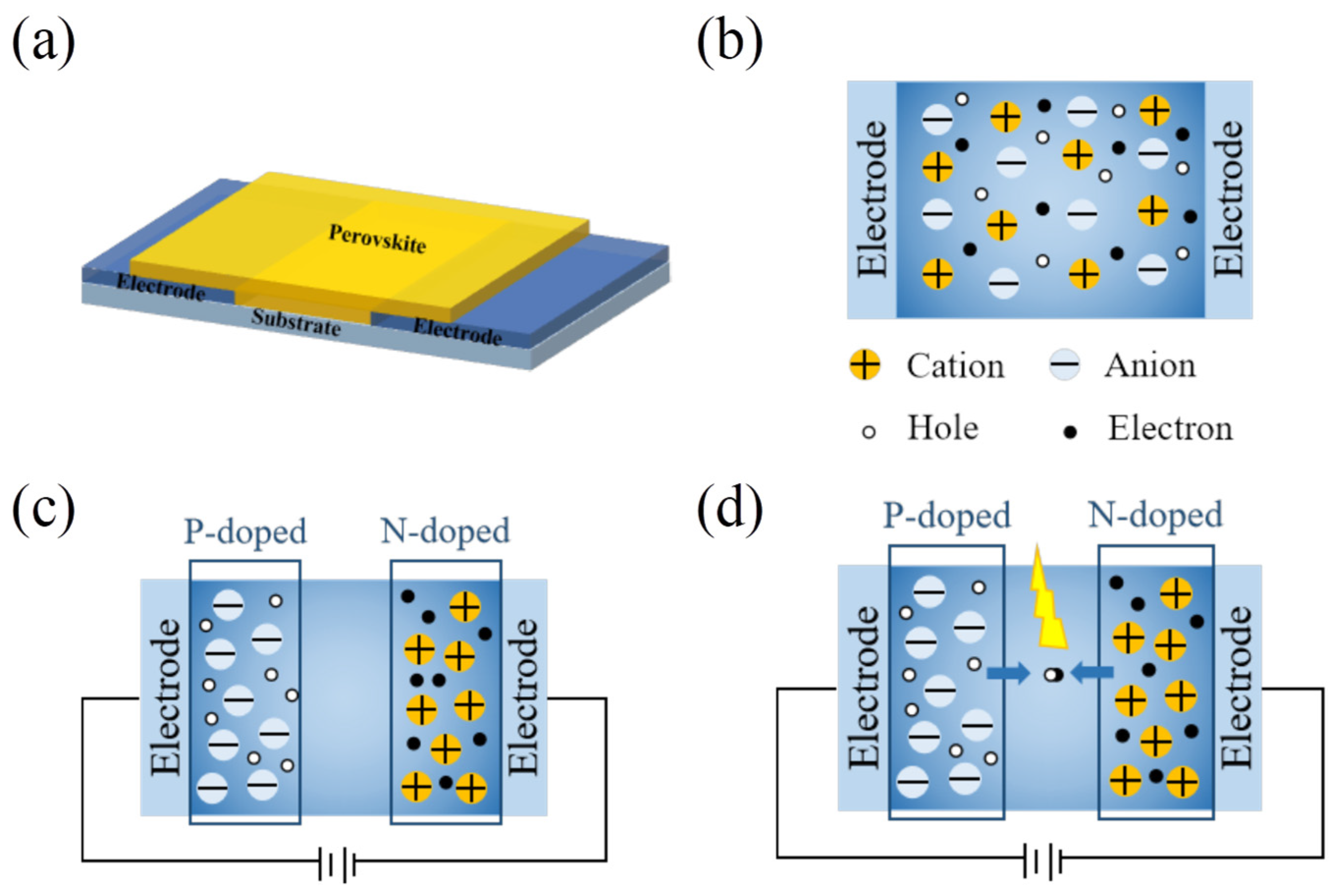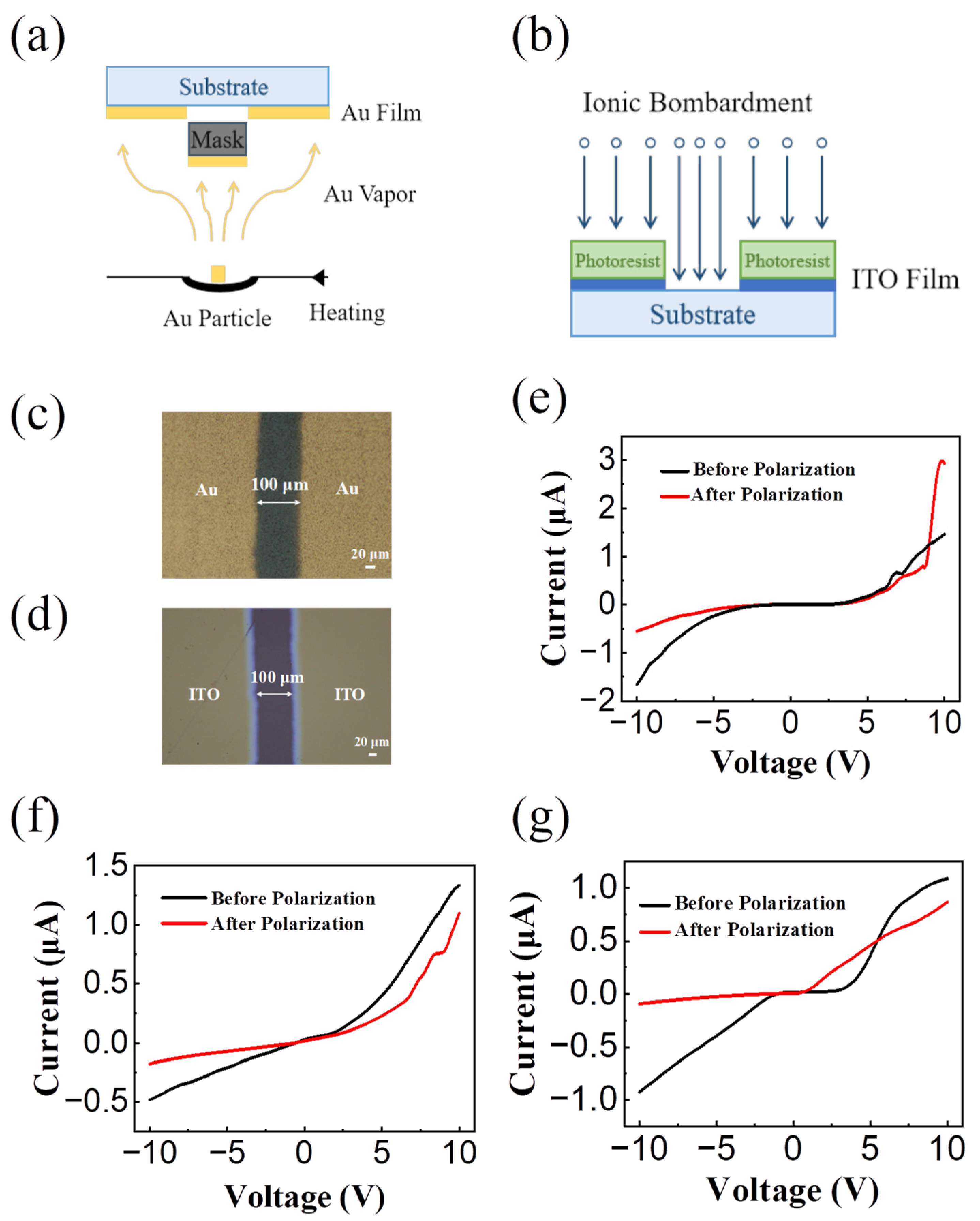Microscale Lateral Perovskite Light Emitting Diode Realized by Self-Doping Phenomenon
Abstract
1. Introduction
2. Materials and Methods
3. Results and Discussion
3.1. Electrode Material
3.2. Ion Migration and Passivation Process
3.3. Polarization Method
4. Conclusions
Supplementary Materials
Author Contributions
Funding
Institutional Review Board Statement
Informed Consent Statement
Data Availability Statement
Conflicts of Interest
References
- Xuan, T.; Shi, S.; Wang, L.; Kuo, H.-C.; Xie, R.-J. Inkjet-Printed Quantum Dot Color Conversion Films for High-Resolution and Full-Color Micro Light-Emitting Diode Displays. J. Phys. Chem. Lett. 2020, 11, 5184–5191. [Google Scholar] [CrossRef]
- Zhuang, Z.; Iida, D.; Ohkawa, K. InGaN-Based Red Light-Emitting Diodes: From Traditional to Micro-LEDs. Jpn. J. Appl. Phys. 2022, 61, SA0809. [Google Scholar] [CrossRef]
- Li, K.H.; Fu, W.Y.; Choi, H.W. Chip-Scale GaN Integration. Prog. Quantum Electron. 2020, 70, 100247. [Google Scholar] [CrossRef]
- Chen, D.; Chen, Y.-C.; Zeng, G.; Zhang, D.W.; Lu, H.-L. Integration Technology of Micro-LED for Next-Generation Display. Research 2023, 6, 0047. [Google Scholar] [CrossRef]
- Zhang, S.; Zheng, H.; Zhou, L.; Li, H.; Chen, Y.; Wei, C.; Wu, T.; Lv, W.; Zhang, G.; Zhang, S.; et al. Research Progress of Micro-LED Display Technology. Crystals 2023, 13, 1001. [Google Scholar] [CrossRef]
- Li, P.; Li, H.; Wong, M.S.; Chan, P.; Yang, Y.; Zhang, H.; Iza, M.; Speck, J.S.; Nakamura, S.; Denbaars, S.P. Progress of InGaN-Based Red Micro-Light Emitting Diodes. Crystals 2022, 12, 541. [Google Scholar] [CrossRef]
- Zhang, Y.; Xu, R.; Kang, Q.; Zhang, X.; Zhang, Z. Recent Advances on GaN-Based Micro-LEDs. Micromachines 2023, 14, 991. [Google Scholar] [CrossRef]
- Li, D.; Dong, X.; Cheng, P.; Song, L.; Wu, Z.; Chen, Y.; Huang, W. Metal Halide Perovskite/Electrode Contacts in Charge-Transporting-Layer-Free Devices. Adv. Sci. 2022, 9, 2203683. [Google Scholar] [CrossRef]
- Kumawat, N.K.; Gupta, D.; Kabra, D. Recent Advances in Metal Halide-Based Perovskite Light-Emitting Diodes. Energy Technol. 2017, 5, 1734–1749. [Google Scholar] [CrossRef]
- Jiang, Q.; Zhao, Y.; Zhang, X.; Yang, X.; Chen, Y.; Chu, Z.; Ye, Q.; Li, X.; Yin, Z.; You, J. Surface Passivation of Perovskite Film for Efficient Solar Cells. Nat. Photonics 2019, 13, 460–466. [Google Scholar] [CrossRef]
- Correa-Baena, J.-P.; Abate, A.; Saliba, M.; Tress, W.; Jesper Jacobsson, T.; Grätzel, M.; Hagfeldt, A. The Rapid Evolution of Highly Efficient Perovskite Solar Cells. Energy Environ. Sci. 2017, 10, 710–727. [Google Scholar] [CrossRef]
- Chen, J.; Xiang, H.; Wang, J.; Wang, R.; Li, Y.; Shan, Q.; Xu, X.; Dong, Y.; Wei, C.; Zeng, H. Perovskite White Light Emitting Diodes: Progress, Challenges, and Opportunities. ACS Nano 2021, 15, 17150–17174. [Google Scholar] [CrossRef]
- Yang, X.; Ma, L.; Li, L.; Luo, M.; Wang, X.; Gong, Q.; Lu, C.; Zhu, R. Towards Micro-PeLED Displays. Nat. Rev. Mater. 2023, 8, 341–353. [Google Scholar] [CrossRef]
- An, H.J.; Kim, M.S.; Myoung, J.-M. Strategy for the Fabrication of Perovskite-Based Green Micro LED for Ultra High-Resolution Displays by Micro-Molding Process and Surface Passivation. Chem. Eng. J. 2023, 453, 139927. [Google Scholar] [CrossRef]
- Fang, T.; Wang, T.; Li, X.; Dong, Y.; Bai, S.; Song, J. Perovskite QLED with an External Quantum Efficiency of over 21% by Modulating Electronic Transport. Sci. Bull. 2021, 66, 36–43. [Google Scholar] [CrossRef]
- Lin, K.; Xing, J.; Quan, L.N.; De Arquer, F.P.G.; Gong, X.; Lu, J.; Xie, L.; Zhao, W.; Zhang, D.; Yan, C.; et al. Perovskite Light-Emitting Diodes with External Quantum Efficiency Exceeding 20 per Cent. Nature 2018, 562, 245–248. [Google Scholar] [CrossRef]
- Zhao, B.; Lian, Y.; Cui, L.; Divitini, G.; Kusch, G.; Ruggeri, E.; Auras, F.; Li, W.; Yang, D.; Zhu, B.; et al. Efficient Light-Emitting Diodes from Mixed-Dimensional Perovskites on a Fluoride Interface. Nat. Electron. 2020, 3, 704–710. [Google Scholar] [CrossRef]
- Luo, Y.; Kong, L.; Wang, L.; Shi, X.; Yuan, H.; Li, W.; Wang, S.; Zhang, Z.; Zhu, W.; Yang, X. A Multifunctional Ionic Liquid Additive Enabling Stable and Efficient Perovskite Light-Emitting Diodes. Small 2022, 18, 2200498. [Google Scholar] [CrossRef]
- Han, X.; Wu, W.; Chen, H.; Peng, D.; Qiu, L.; Yan, P.; Pan, C. Metal Halide Perovskite Arrays: From Construction to Optoelectronic Applications. Adv. Funct. Mater. 2021, 31, 2005230. [Google Scholar] [CrossRef]
- Zou, C.; Chang, C.; Sun, D.; Böhringer, K.F.; Lin, L.Y. Photolithographic Patterning of Perovskite Thin Films for Multicolor Display Applications. Nano Lett. 2020, 20, 3710–3717. [Google Scholar] [CrossRef]
- Hsu, C.; Tian, S.; Lian, Y.; Zhang, G.; Zhou, Q.; Cao, X.; Zhao, B.; Di, D. Efficient Mini/Micro-Perovskite Light-Emitting Diodes. Cell Rep. Phys. Sci. 2021, 2, 100582. [Google Scholar] [CrossRef]
- Cheng, J.; Ma, Y.; Zhou, W.; Zhang, T.; Li, W.; Zhang, X.; Yan, H.; Li, J.; Zheng, Z.; Chen, X.; et al. A Universal Microscopic Patterned Doping Method for Perovskite Enables Ultrafast, Self-Powered, Ultrasmall Perovskite Photodiodes. Adv. Mater. 2023, 35, 2300691. [Google Scholar] [CrossRef]
- Li, P.; Wang, J.; Chen, H.; Zhang, H.; Li, C.; Xu, W.; Li, R.; Zhu, L.; Wang, N.; Wang, J. Multiple-Quantum-Well Perovskite for Hole-Transport-Layer-Free Light-Emitting Diodes. Chin. Chem. Lett. 2022, 33, 1017–1020. [Google Scholar] [CrossRef]
- Teng, P.; Reichert, S.; Xu, W.; Yang, S.-C.; Fu, F.; Zou, Y.; Yin, C.; Bao, C.; Karlsson, M.; Liu, X.; et al. Degradation and Self-Repairing in Perovskite Light-Emitting Diodes. Matter 2021, 4, 3710–3724. [Google Scholar] [CrossRef]
- Cheng, L.; Huang, J.; Shen, Y.; Li, G.; Liu, X.; Li, W.; Wang, Y.; Li, Y.; Jiang, Y.; Gao, F.; et al. Efficient CsPbBr3 Perovskite Light-Emitting Diodes Enabled by Synergetic Morphology Control. Adv. Opt. Mater. 2019, 7, 1801534. [Google Scholar] [CrossRef]
- Tang, J.; Pan, J.; Han, J.; Liu, Z.; Zhou, S.; Zhu, X.; Yu, H.; Wang, K.; Chen, X.; Li, J. Tetrafluoride Anion Substitution and Its Role on Performance Enhancement in Quasi-2D Perovskite Light-Emitting Diode. Org. Electron. 2024, 127, 107003. [Google Scholar] [CrossRef]
- Sadhukhan, P.; Kim, M.S.; Baek, S.; Myoung, J. Super-Bright Green Perovskite Light-Emitting Diodes Using Ionic Liquid Additives. Small Methods 2023, 7, 2201407. [Google Scholar] [CrossRef]
- Zhang, D.; Fu, Y.; Zhan, H.; Zhao, C.; Gao, X.; Qin, C.; Wang, L. Suppressing Thermal Quenching via Defect Passivation for Efficient Quasi-2D Perovskite Light-Emitting Diodes. Light Sci. Appl. 2022, 11, 69. [Google Scholar] [CrossRef]
- Lee, J.Y.; Kim, S.Y.; Yoon, H.J. Small Molecule Approach to Passivate Undercoordinated Ions in Perovskite Light Emitting Diodes: Progress and Challenges. Adv. Opt. Mater. 2022, 10, 2101361. [Google Scholar] [CrossRef]
- Yang, D.; Huo, D. Cation Doping and Strain Engineering of CsPbBr3-Based Perovskite Light Emitting Diodes. J. Mater. Chem. C 2020, 8, 6640–6653. [Google Scholar] [CrossRef]





Disclaimer/Publisher’s Note: The statements, opinions and data contained in all publications are solely those of the individual author(s) and contributor(s) and not of MDPI and/or the editor(s). MDPI and/or the editor(s) disclaim responsibility for any injury to people or property resulting from any ideas, methods, instructions or products referred to in the content. |
© 2024 by the authors. Licensee MDPI, Basel, Switzerland. This article is an open access article distributed under the terms and conditions of the Creative Commons Attribution (CC BY) license (https://creativecommons.org/licenses/by/4.0/).
Share and Cite
Gao, W.; Huang, H.; Wang, C.; Zhang, Y.; Zheng, Z.; Li, J.; Chen, X. Microscale Lateral Perovskite Light Emitting Diode Realized by Self-Doping Phenomenon. Sensors 2024, 24, 4454. https://doi.org/10.3390/s24144454
Gao W, Huang H, Wang C, Zhang Y, Zheng Z, Li J, Chen X. Microscale Lateral Perovskite Light Emitting Diode Realized by Self-Doping Phenomenon. Sensors. 2024; 24(14):4454. https://doi.org/10.3390/s24144454
Chicago/Turabian StyleGao, Wenzhe, He Huang, Chenming Wang, Yongzhe Zhang, Zilong Zheng, Jinpeng Li, and Xiaoqing Chen. 2024. "Microscale Lateral Perovskite Light Emitting Diode Realized by Self-Doping Phenomenon" Sensors 24, no. 14: 4454. https://doi.org/10.3390/s24144454
APA StyleGao, W., Huang, H., Wang, C., Zhang, Y., Zheng, Z., Li, J., & Chen, X. (2024). Microscale Lateral Perovskite Light Emitting Diode Realized by Self-Doping Phenomenon. Sensors, 24(14), 4454. https://doi.org/10.3390/s24144454





